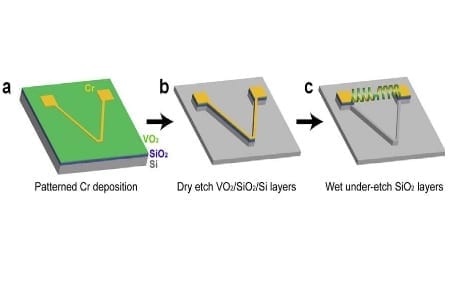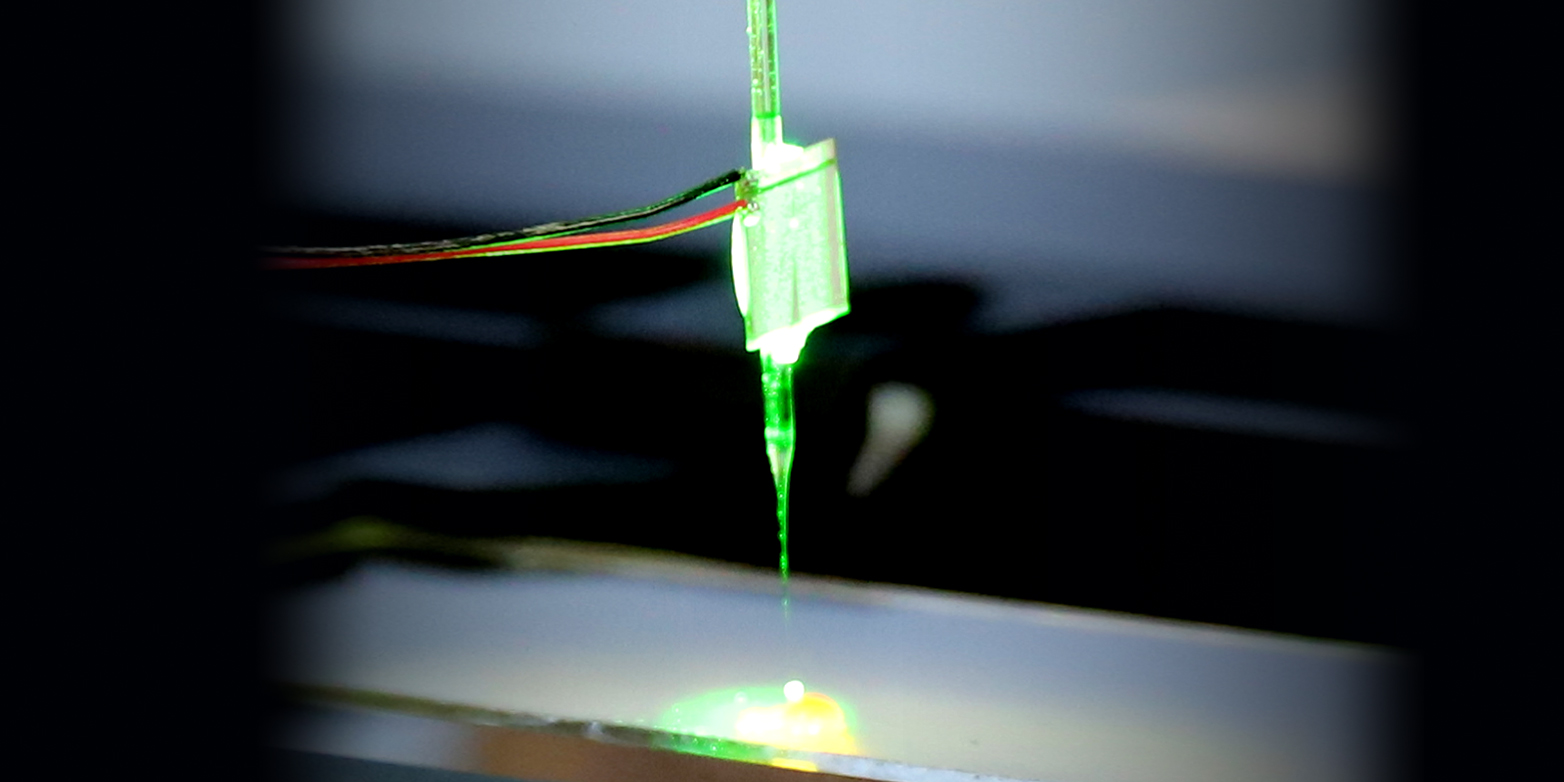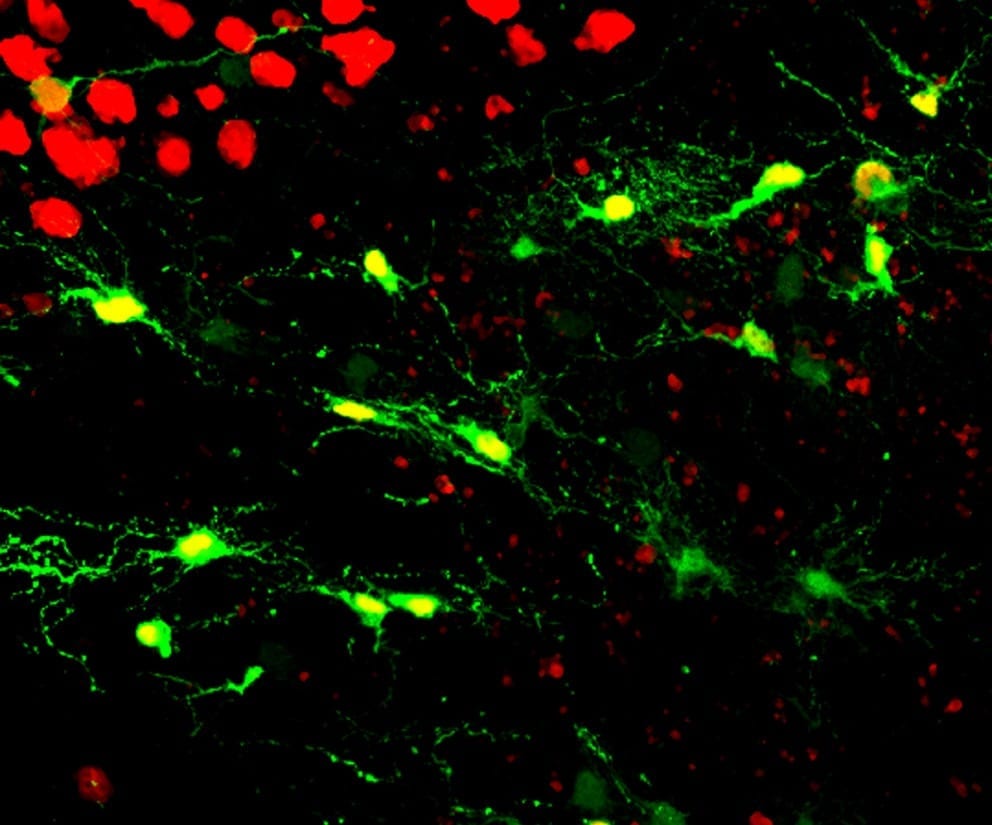
A thousand times more powerful than a human muscle, able to catapult objects 50 times heavier than itself over a distance five times its length within 60 milliseconds – faster than the blink of an eye.
Berkeley Lab Researchers Make a Powerful New Microscale Torsional Muscle/Motor from Vanadium Dioxide
Vanadium dioxide is poised to join the pantheon of superstars in the materials world. Already prized for its extraordinary ability to change size, shape and physical identity, vanadium dioxide can now add muscle power to its attributes. A team of researchers with the U.S. Department of Energy (DOE)’s Lawrence Berkeley National Laboratory (Berkeley Lab) has demonstrated a micro-sized robotic torsional muscle/motor made from vanadium dioxide that for its size is a thousand times more powerful than a human muscle, able to catapult objects 50 times heavier than itself over a distance five times its length within 60 milliseconds – faster than the blink of an eye.
“We’ve created a micro-bimorph dual coil that functions as a powerful torsional muscle, driven thermally or electro-thermally by the phase transition of vanadium dioxide,” says the leader of this work, Junqiao Wu, a physicist who holds joint appointments with Berkeley Lab’s Materials Sciences Division and the University of California-Berkeley’s Department of Materials Science and Engineering. “Using a simple design and inorganic materials, we achieve superior performance in power density and speed over the motors and actuators now used in integrated micro-systems.”
Wu is the corresponding author of a paper describing this research in the journal Advanced Materials. The paper is titled “Powerful, Multifunctional Torsional Micro Muscles Activated by Phase Transition.” Co-authors are Kai Liu, Chun Cheng, Joonki Suh, Robert Tang-Kong, Deyi Fu, Sangwook Lee, Jian Zhou and Leon Chua.
What makes vanadium dioxide highly coveted by the electronics industry is that it is one of the few known materials that’s an insulator at low temperatures but abruptly becomes a conductor at 67 degrees Celsius. This temperature-driven phase transition from insulator-to-metal is expected to one day yield faster, more energy efficient electronic and optical devices. However, vanadium dioxide crystals also undergo a temperature-driven structural phase transition whereby when warmed they rapidly contract along one dimension while expanding along the other two. This makes vanadium dioxide an ideal candidate material for creating miniaturized, multi-functional motors and artificial muscles.
“Miniaturizing rotary motors is important for integrated micro-systems and has been intensively pursued over the past decades,” Wu says. “The power density of our micro-muscle in combination with its multi-functionality distinguishes it from all current macro- or micro-torsional actuators/motors.”
Wu and his colleagues fabricated their micro-muscle on a silicon substrate from a long “V-shaped” bimorph ribbon comprised of chromium and vanadium dioxide. When the V-shaped ribbon is released from the substrate it forms a helix consisting of a dual coil that is connected at either end to chromium electrode pads. Heating the dual coil actuates it, turning it into either a micro-catapult, in which an object held in the coil is hurled when the coil is actuated, or a proximity sensor, in which the remote sensing of an object (meaning without touching it) causes a “micro-explosion,” a rapid change in the micro-muscle’s resistance and shape that pushes the object away.
“Multiple micro-muscles can be assembled into a micro-robotic system that simulates an active neuromuscular system,” Wu says. “The naturally combined functions of proximity sensing and torsional motion allow the device to remotely detect a target and respond by reconfiguring itself to a different shape. This simulates living bodies where neurons sense and deliver stimuli to the muscles and the muscles provide motion.”
The vanadium dioxide micro-muscles demonstrated reversible torsional motion over one million cycles with no degradation. They also showed a rotational speed of up to approximately 200,000 rpm, amplitude of 500 to 2,000 degrees per millimeters in length, and an energy power density up to approximately 39 kilowatts/kilogram.
“These metrics are all orders of magnitudes higher than existing torsional motors based on electrostatics, magnetics, carbon nanotubes or piezoelectrics,” Wu says.
The Latest on: Micro-robotic system
[google_news title=”” keyword=”Micro-robotic system” num_posts=”10″ blurb_length=”0″ show_thumb=”left”]
via Google News
The Latest on: Micro-robotic system
- Save $400 on Samsung’s new AI-powered robot vacuumon April 27, 2024 at 1:05 pm
Grab a super powerful and intelligent robot vacuum from Samsung for $400 off and have the cleanest home possible for less.
- Automation for Plastics Processors Is on the Move at Muller Technologyon April 26, 2024 at 11:57 am
For plastics processors, Muller serves as a single source of comprehensive automation from the mold to case packers and end-of-line logistics. Muller is a partner of AMR manufacturer Omron, and as an ...
- Asylon Robotics Achieves BVLOS Approval for Advanced Drone Systemon April 26, 2024 at 11:22 am
New BVLOS Certification Expands Possibilities for Remote Drone Operations in Security Applications by DRONELIFE Contributer Ian J. McNab Pennsylvania-based manufacturer Asylon Robotics recently announ ...
- Ubiros Gentle grippers go all electric for reliability, flexibilityon April 26, 2024 at 10:38 am
Ubiros has developed grippers with force-sensing capabilities to bring automation to more picking tasks, explains President Onder Ondemir.
- JR Automation to boost medical device presence in deal for German firmon April 26, 2024 at 9:00 am
Hitachi Ltd. has reached an agreement to acquire a German robotics and automation firm that will join and expand the global presence of Holland-based JR Automation Technologies LLC.
- HITACHI ACQUIRES MA MICRO AUTOMATION OF GERMANY IN EFFORT TO ACCELERATE GLOBAL EXPANSION OF ROBOTIC SI BUSINESS IN THE MEDICAL AND OTHER FIELDSon April 26, 2024 at 4:08 am
Hitachi Ltd. (TSE: 6501, "Hitachi") has signed a stock purchase agreement on April 26 to acquire all shares of MA micro automation GmbH ("MA micro automation", headquartered in St. Leon-Rot, Germany) ...
- EQS-News: MAX Automation SE concludes agreement on sale of MA micro Groupon April 26, 2024 at 3:47 am
EQS-News: MAX Automation SE / Key word (s): Disposal MAX Automation SE concludes agreement on sale of MA micro Group 26.04.2024 / 12:10 CET/CEST The issuer is solely responsible for the content of ...
- Automated machine learning robot unlocks new potential for genetics researchon April 25, 2024 at 5:00 pm
Researchers have constructed a robot that uses machine learning to fully automate a complicated microinjection process used in genetic research. University of Minnesota Twin Cities researchers have ...
- New tether system provides Vesper unlimited flight timeon April 25, 2024 at 6:00 am
Volarious, a company specializing in tethered drone solutions, and Vantage Robotics, Inc., announce the launch of the V-Line Pro Vesper, a tethered drone system compatible with the Vesper micro UAV.
- $300,000 robotic micro-factories pump out custom-designed homeson April 20, 2024 at 12:57 am
Construction is the world’s largest industry, contributing 13% of global GDP. It is also the most inefficient, least digitised and most polluting industry. Now AUAR has begun rolling out an ingenious ...
via Bing News











